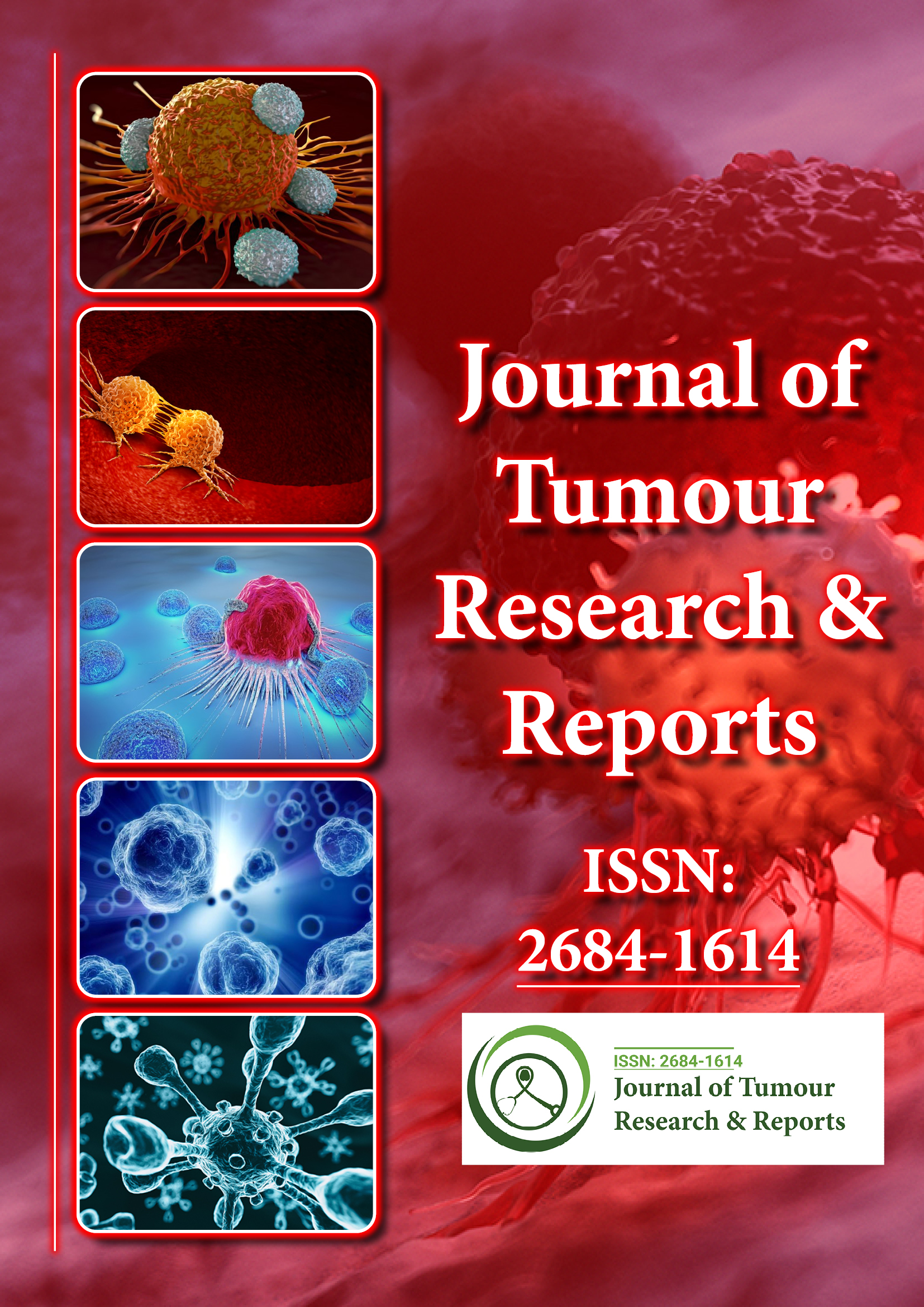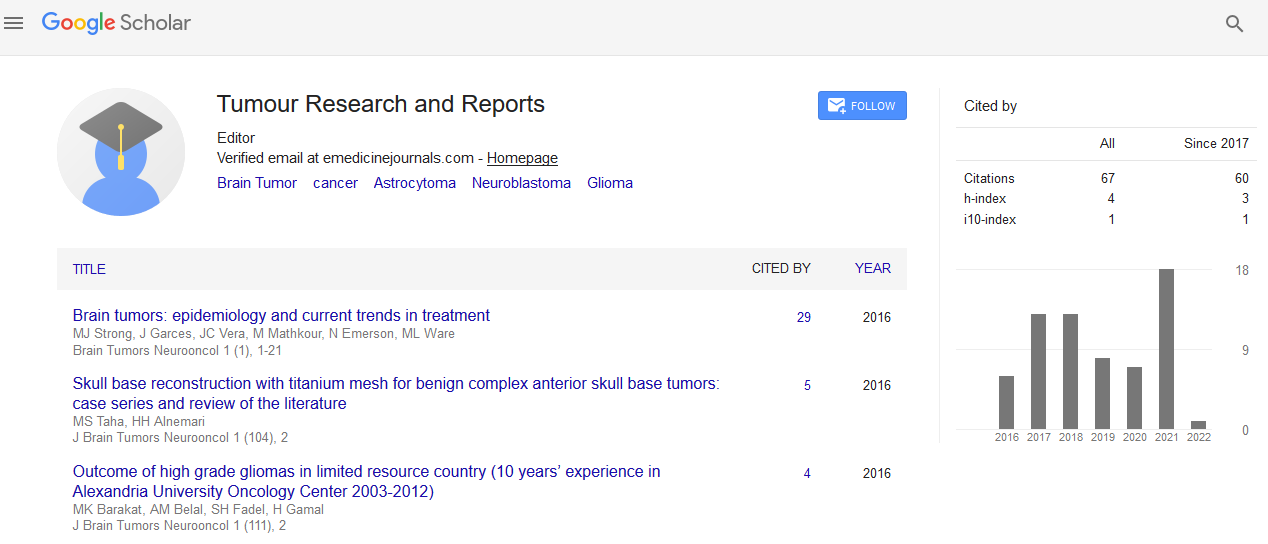Indexed In
- RefSeek
- Hamdard University
- EBSCO A-Z
- Google Scholar
Useful Links
Share This Page
Journal Flyer

Open Access Journals
- Agri and Aquaculture
- Biochemistry
- Bioinformatics & Systems Biology
- Business & Management
- Chemistry
- Clinical Sciences
- Engineering
- Food & Nutrition
- General Science
- Genetics & Molecular Biology
- Immunology & Microbiology
- Medical Sciences
- Neuroscience & Psychology
- Nursing & Health Care
- Pharmaceutical Sciences
Short Communication - (2025) Volume 10, Issue 2
Future Directions in Tumour Research: From Genomics to Systems Oncology
Hiroshi Tanaka*Received: 30-May-2025, Manuscript No. JTRR-25-29826; Editor assigned: 02-Jun-2025, Pre QC No. JTRR-25-29826 (PQ); Reviewed: 16-Jun-2025, QC No. JTRR-25-29826; Revised: 23-Jun-2025, Manuscript No. JTRR-25-29826 (R); Published: 30-Jun-2025, DOI: 10.35248/2684-1614.25.10.263
Description
The field of tumour research stands at a pivotal crossroads, shaped by rapid advances in biology, technology, and data science that are opening opportunities unimaginable just a generation ago. Where oncology was once confined to histopathology and the microscopic study of abnormal growth, it has now evolved into a multidisciplinary enterprise that integrates genomics, immunology, computational modeling, and systems biology. The future directions of tumour research reflect this transformation, with the promise of shifting cancer from a disease defined by despair into one that can be understood, controlled, and ultimately prevented. Central to this transition is the growing recognition that cancer must be studied not as a simple pathology but as a complex, adaptive system whose behaviour emerges from the interplay of genes, proteins, cells, and microenvironments [1-3].
One of the most revolutionary developments has been the sequencing of cancer genomes. International efforts such as The Cancer Genome Atlas and the International Cancer Genome Consortium have catalogued thousands of tumours, uncovering both recurrent driver mutations and rare alterations that may be unique to individual patients. These projects revealed the staggering diversity of mutational landscapes, demonstrating that no two tumours are exactly alike. Yet, while sequencing provides the blueprint of cancer, understanding how these mutations interact in dynamic cellular networks remains a challenge. Systems biology approaches are increasingly being employed to connect these genetic alterations with disrupted pathways, signalling cascades, and metabolic shifts. By integrating genomic, epigenomic, proteomic, and metabolomic data, researchers aim to construct predictive models that capture the complexity of tumour behaviour and allow therapeutic interventions to be targeted more precisely [4-6].
The role of artificial intelligence and machine learning in this evolving landscape cannot be overstated. These technologies are uniquely suited to manage the vast and complex datasets that modern oncology generates. Machine learning algorithms can identify patterns invisible to the human eye, generating hypotheses that guide experimental work and clinical trials. In diagnostics, AI is being applied to digital pathology, radiology scans, and genomic data to improve accuracy, reproducibility, and efficiency. In drug discovery, deep learning models are predicting compound efficacy and toxicity, accelerating the development of new therapies while reducing cost and failure rates. The integration of AI into tumour research is part of a broader trend toward data-driven science, where computational tools augment human intuition and bring a new level of precision to oncology [7-9].
Precision medicine exemplifies the shift toward individualized care, tailoring therapy to the unique characteristics of each patient’s tumour. Advances in biomarker discovery, liquid biopsy technologies, and patient-derived xenografts or organoids are enabling more accurate prediction of treatment response and resistance. However, the promise of precision medicine is tempered by the realities of intratumour heterogeneity and clonal evolution, which allow tumours to adapt and escape even the most sophisticated therapies. To address this, researchers are exploring adaptive clinical trial designs that allow therapies to be modified in real time based on patient-specific data, reflecting the evolving nature of cancer. Such approaches, though complex, hold the potential to transform precision oncology from a static concept into a dynamic, iterative process.
Future therapeutic strategies will likely converge across multiple modalities. Immunotherapies, which harness the power of the immune system, have already revolutionized treatment for cancers such as melanoma and lung carcinoma, yet challenges of resistance and patient variability remain. Targeted therapies directed at specific molecular drivers offer precision but often encounter relapse due to secondary mutations. Metabolic interventions, which disrupt the unique metabolic demands of tumour cells, are emerging as an additional frontier. Combination therapies that integrate these approaches—immunotherapy, targeted therapy, and metabolic modulation—may provide the most durable responses by attacking cancer from multiple angles. Advances in gene editing and synthetic biology add another layer of innovation, raising the possibility of engineering immune cells, microbiomes, or even synthetic circuits to combat cancer in ways previously limited to theory [10].
References
- Katsura C, Ogunmwonyi I, Kankam HK, Saha S. Breast cancer: Presentation, investigation and management. Br J Hosp Med (Lond). 2022;83(2):1-7.
- Barzaman K, Karami J, Zarei Z, Hosseinzadeh A, Kazemi MH, Moradi-Kalbolandi S, et al. Breast cancer: Biology, biomarkers, and treatments. Int Immunopharmacol. 2020;84:106535.
- Xiong X, Zheng LW, Ding Y, Chen YF, Cai YW, Wang LP, et al. Breast cancer: Pathogenesis and treatments. Signal Transduct Target Ther. 2025;10(1):49 .
- Li Z, Wei H, Li S, Wu P, Mao X. The role of progesterone receptors in breast cancer. Drug Des Devel Ther. 2022:305-14.
- Zhang YN, Xia KR, Li CY, Wei BL, Zhang B. Review of breast cancer pathologigcal image processing. Biomed Res Int. 2021(1):1994764.
- Bodewes FT, Van Asselt AA, Dorrius MD, Greuter MJ, De Bock GH. Mammographic breast density and the risk of breast cancer: A systematic review and meta-analysis. The Breast. 2022;66:62-8.
- Britt KL, Cuzick J, Phillips KA. Key steps for effective breast cancer prevention. Nat Rev Cancer. 2020;20(8):417-436.
- Fahad Ullah M. Breast cancer: current perspectives on the disease status. Breast cancer metastasis and drug resistance: Challenges and progress. 2019:51-64.
- Qi YJ, Su GH, You C, Zhang X, Xiao Y, Jiang YZ, et al. Radiomics in breast cancer: Current advances and future directions. Cell Reports Medicine. 2024:5(9).
- Tesch ME, Partridge AH. Treatment of breast cancer in young adults. Am Soc Clin Oncol Educ Book. 2022; 42:1-12.
Citation: Tanaka H (2025). Future Directions in Tumour Research: From Genomics to Systems Oncology. J Tum Res Reports. 10:263.
Copyright: © 2025 Tanaka H. This is an open-access article distributed under the terms of the Creative Commons Attribution License, which permits unrestricted use, distribution, and reproduction in any medium, provided the original author and source are credited.

